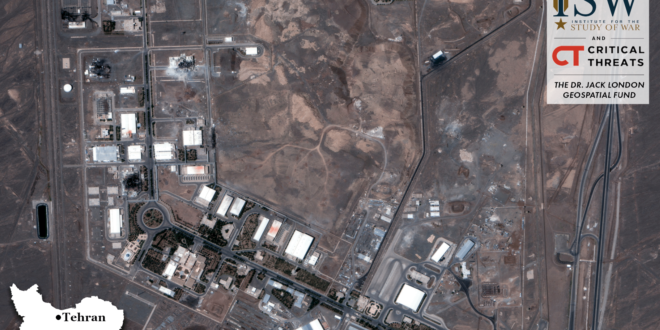Key Takeaways
The United States conducted strikes targeting three nuclear facilities with bunker-buster bombs and Tomahawk cruise missiles. The US chairman of the Joint Chiefs of Staff said all three sites sustained “extreme damage.” Israeli officials echoed that statement, though they added the Fordow nuclear facility was “not destroyed.”
Iran began taking steps to retaliate against the United States, including by threatening shipping in the Strait of Hormuz. Iran likely interfered with GPS signals in the Strait of Hormuz on June 22.
Israel continued its air campaign against Iran.US strikes
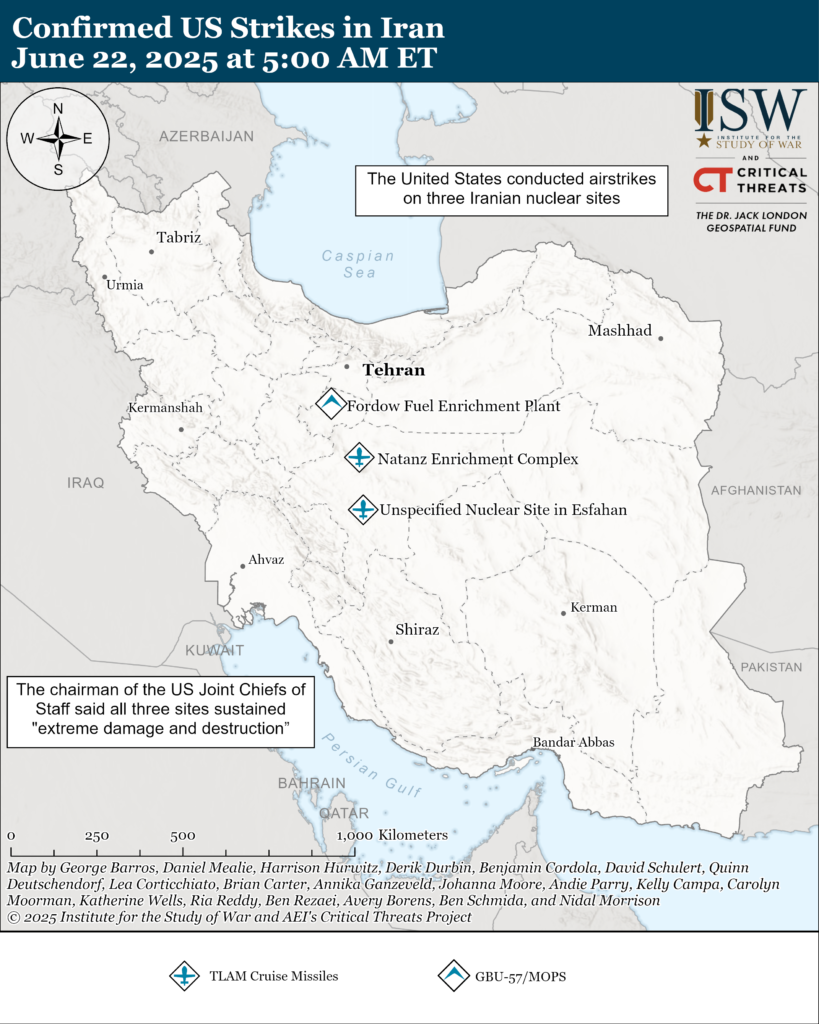
The United States conducted strikes against three Iranian nuclear sites, including the Fordow Fuel Enrichment Plant (FEEP) in Qom Province.[1] A US official told the New York Times that six American warplanes dropped 12 30,000-lb GBU-57 massive ordnance penetrator (MOP) bunker-busting bombs on Fordow.[2] The standard payload of a B-2 bomber is 40,000 lb, but the bomber refueled immediately after takeoff.[3] US President Donald Trump said on June 21 that US strikes were a “spectacular military success” and were a part of the US objective to destroy Iran’s nuclear enrichment capacity.[4] Trump said the facilities were “completely and totally obliterated.” The chairman of the US Joint Chiefs of Staff said all three sites sustained “extreme damage and destruction.”[5] The chairman added that he did not yet have a complete battle damage assessment at this time, however. A senior Israeli official told Axios that US strikes set back Iran’s nuclear program by years.[6] The International Atomic Energy Agency (IAEA) reported that there has been ”no increase in off-site radiation levels” following the attacks.[7]
Satellite imagery of Fordow from June 22 shows six probable entry-point craters on top of a ridge above the underground complex that houses two halls of at least 2000 centrifuges. Approximately half of the centrifuges at Fordow are advanced IR-6 centrifuges. The Wall Street Journal reported that Fordow was producing nearly enough highly enriched uranium to fuel one nuclear weapon per month. Two unspecified Israeli officials with knowledge of the matter said initial Israeli assessments indicate that US strikes did not destroy but inflicted serious damage to the site at Fordow.[8] The officials added that it appears Iran moved materials and equipment from the site ahead of the strike. A senior US official similarly said that the US strikes did not destroy but severely damaged the Fordow nuclear site and took it “off the table.”[9]

The US official also told the New York Times that a US B-2 bomber dropped two GBU-57 MOPs on the Natanz nuclear site.[10] Israel has previously struck Natanz multiple times since the start of Israel’s air campaign against Iran on June 12.[11] IAEA Director General Rafael Grossi previously stated that Israeli strikes likely damaged or destroyed several thousand centrifuges at Natanz.[12] Satellite imagery from June 22 shows a probable entry-point crater at the above-ground complex at the Natanz nuclear site.
The United States separately struck an unspecified nuclear site in Esfahan with cruise missiles.[13] It is unclear what site the US strikes targeted. Israel has previously targeted the Esfahan Nuclear Technology Center (ENTC) on June 13 and 21 and caused substantial damage to several facilities in the complex, including centrifuge production facilities and a uranium conversion plant.[14] Satellite imagery from June 22 shows that US strikes likely damaged additional buildings within the complex. The United States may have also struck a new Iranian nuclear facility south of Natanz in Esfahan Province. The Institute for Science and International Security reported in April 2025 that Iran is constructing a security perimeter around two underground nuclear tunnel complexes located within Mount Kolang Gaz La, south of the Natanz enrichment complex.[15] Iran announced in September 2020 that it was building a tunnel complex near Natanz to make advanced centrifuges after a former centrifuge production facility was destroyed in July 2020.[16]
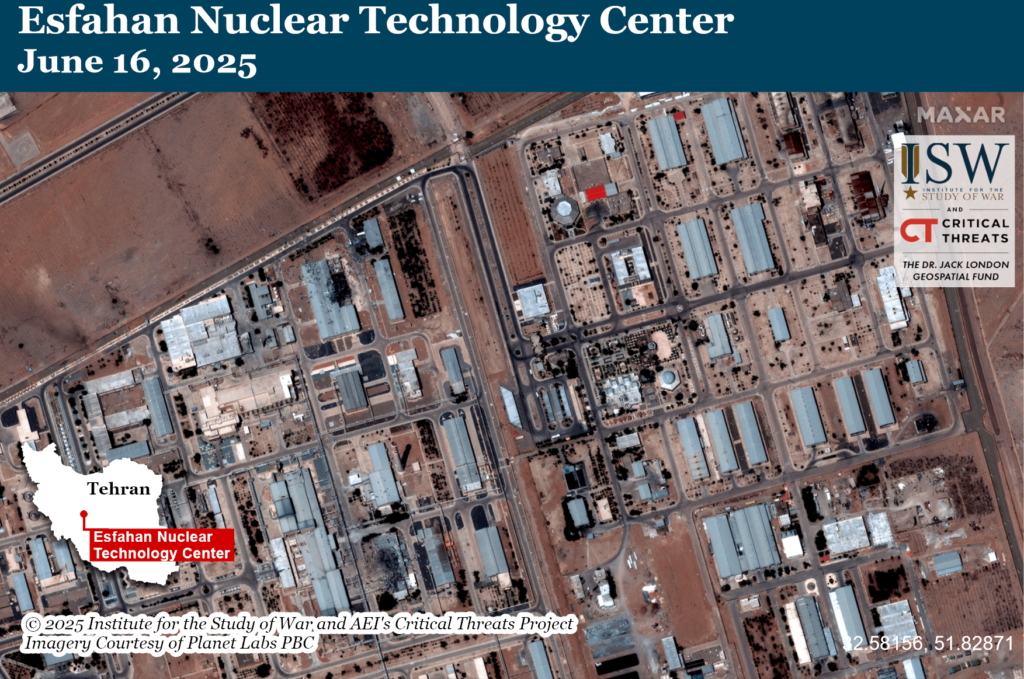
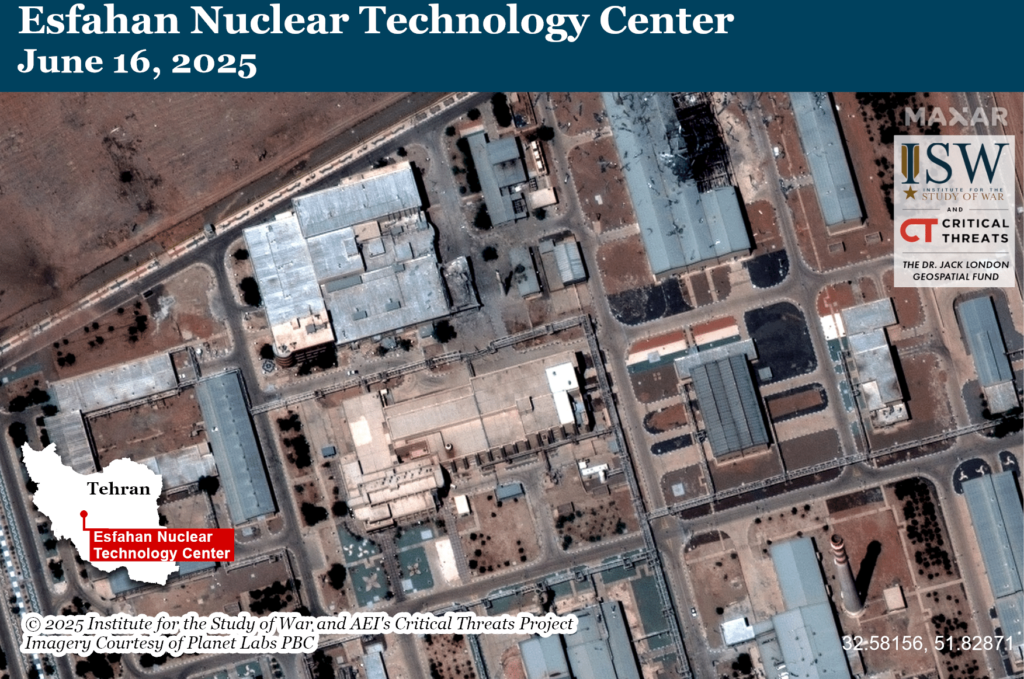

Iran has taken steps to begin its retaliation for the US strikes. The Iranian Parliament approved a measure on June 22 to close the Strait of Hormuz, which would disrupt international shipping.[17] Iranian media reported that the Supreme National Security Council (SNSC) still needs to provide final approval.[18] Iranian Foreign Affairs Minister Abbas Araghchi stated on June 22 that Iran “reserves all options to defend its sovereignty, interests, and people.”[19] An open-source observer citing Windward confirmed that vessels are experiencing Global Positioning System (GPS) interference in the Strait of Hormuz.[20] Iran has previously threatened to disrupt international shipping in response to US or Israeli strikes on Iranian nuclear facilities.[21] Around 20 percent of global oil exports flow through the Strait of Hormuz.
Iran launched two missile barrages at Israel after the US strikes.[22] This attack may or may not be in retaliation for the US strikes on Iran. Iran could expand its retaliation to include attacks on US forces in the region. It may be several days before Iran responds directly against the United States. Iran fired ballistic missiles at US forces at Ain al Asad Airbase in Iraq five days after the US strike that killed IRGC Quds Force commander Qassem Soleimani in January 2020.[23] An Iranian source close to the regime posted on X that it “seems like” Iran’s response to US strikes will include attacking “one or more US positions in the region” and ”continuing the war with Israel with continuous strikes.”[24]
Iran has launched two ballistic missile attacks on Israel since CTP-ISW’s June 21, 5:00 PM EST data cut off.[25] Iran launched the two ballistic missile barrages after the United States conducted strikes against the Fordow Fuel Enrichment Plant and nuclear sites in Esfahan and Natanz.[26] Israeli sources reported missile or interceptor impacts in Haifa and Tel Aviv from the two barrages, which injured several people in both cities.[27] The IDF Air Force also struck six Iranian missile launch platforms and operators arming the missiles to strike Israel on June 22.[28] An IRGC spokesperson announced that these missile attacks employed a mix of long-range liquid- and solid-fuel ballistic missiles.[29] Iran fired between 22 and 30 missiles targeting Israel in these two barrages.[30] Israeli emergency services responded to at least 10 impacts throughout the country.[31]
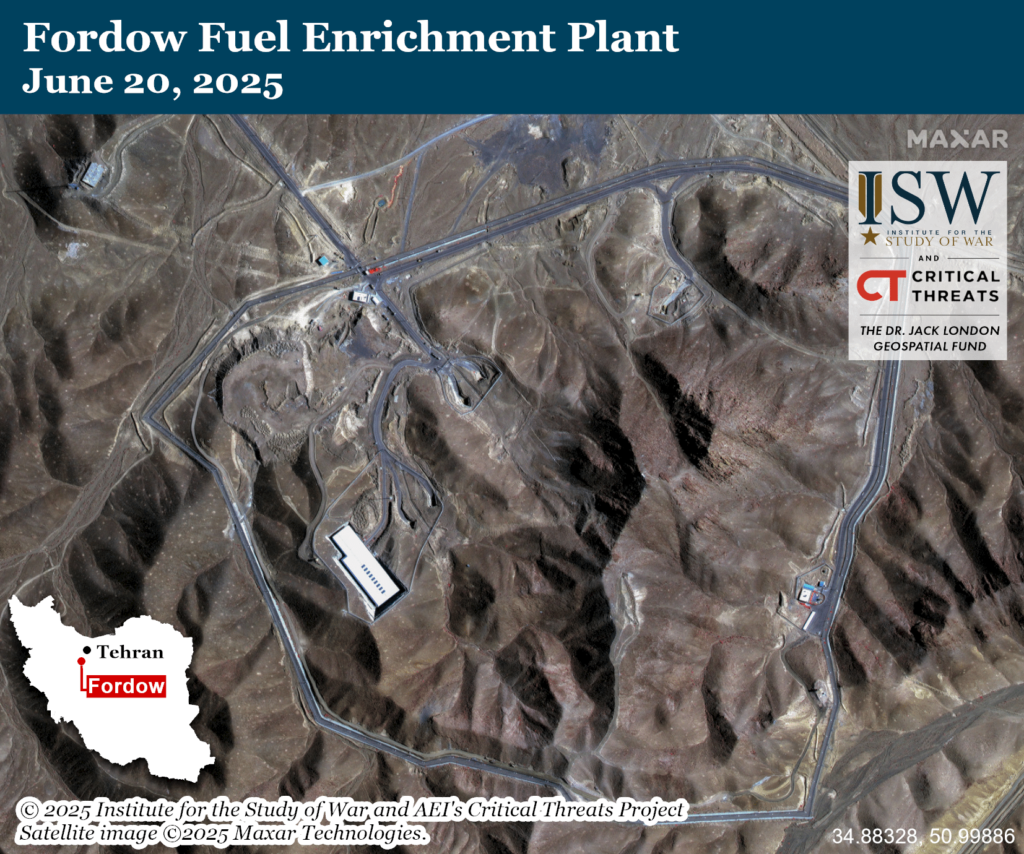
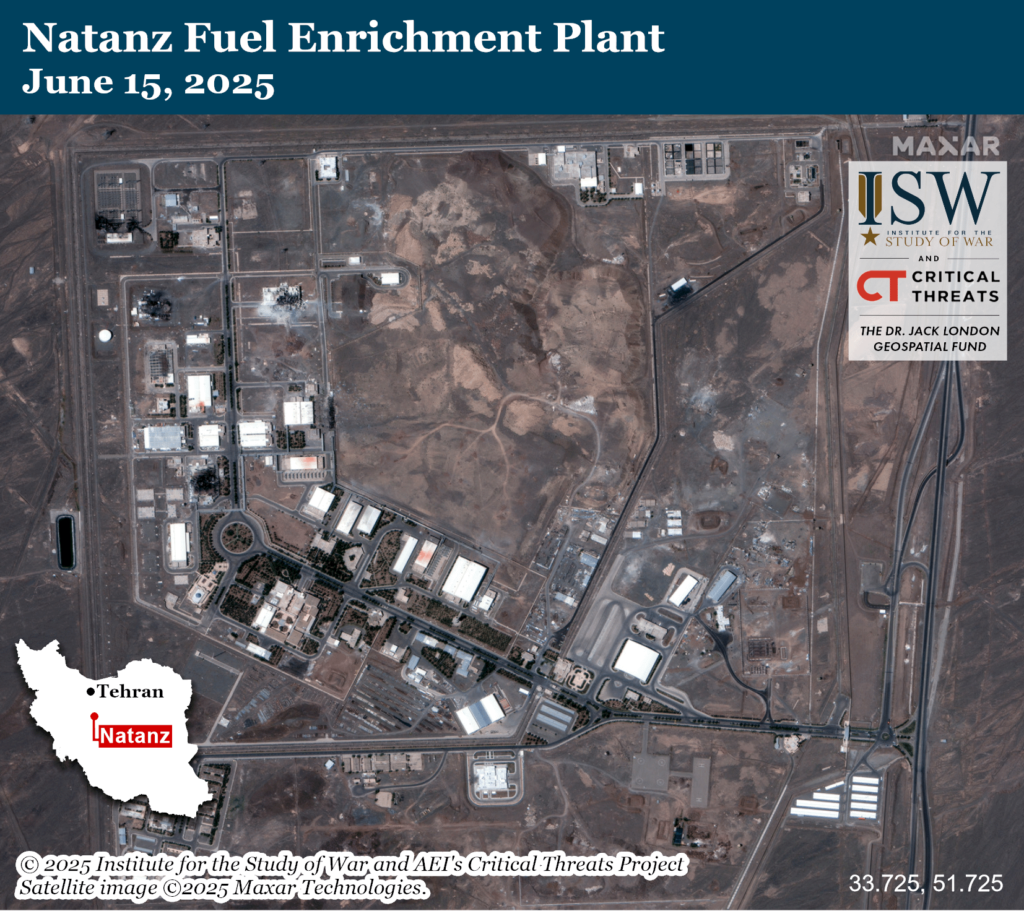
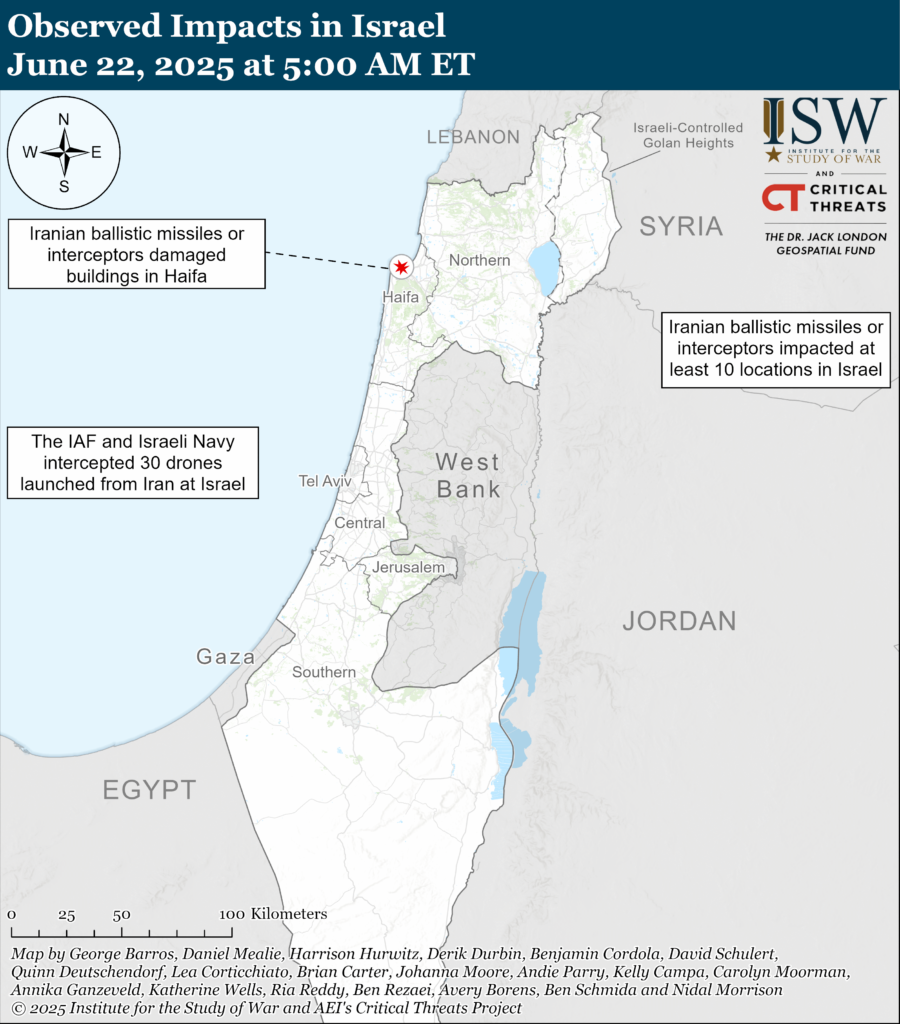
Israeli air defenses have intercepted 30 one-way attack drones launched from Iran overnight.[32] One drone flew over the southern Golan Heights.[33] Two other drones entered near southern Israel.[34]
The IDF continued its campaign to destroy Iranian military infrastructure on June 22. Social media users reported Israeli airstrikes on an IRGC division headquarters in Tabriz, northwest Iran, on June 22.[35] The IRGC 31st Ashoura Mechanized Division operates at the site.[36] CTP-ISW has observed fewer reports of Israeli airstrikes from social media accounts based in Iran, which likely reflects widespread internet disruptions in Iran rather than an actual decrease in Israeli airstrikes.[37]
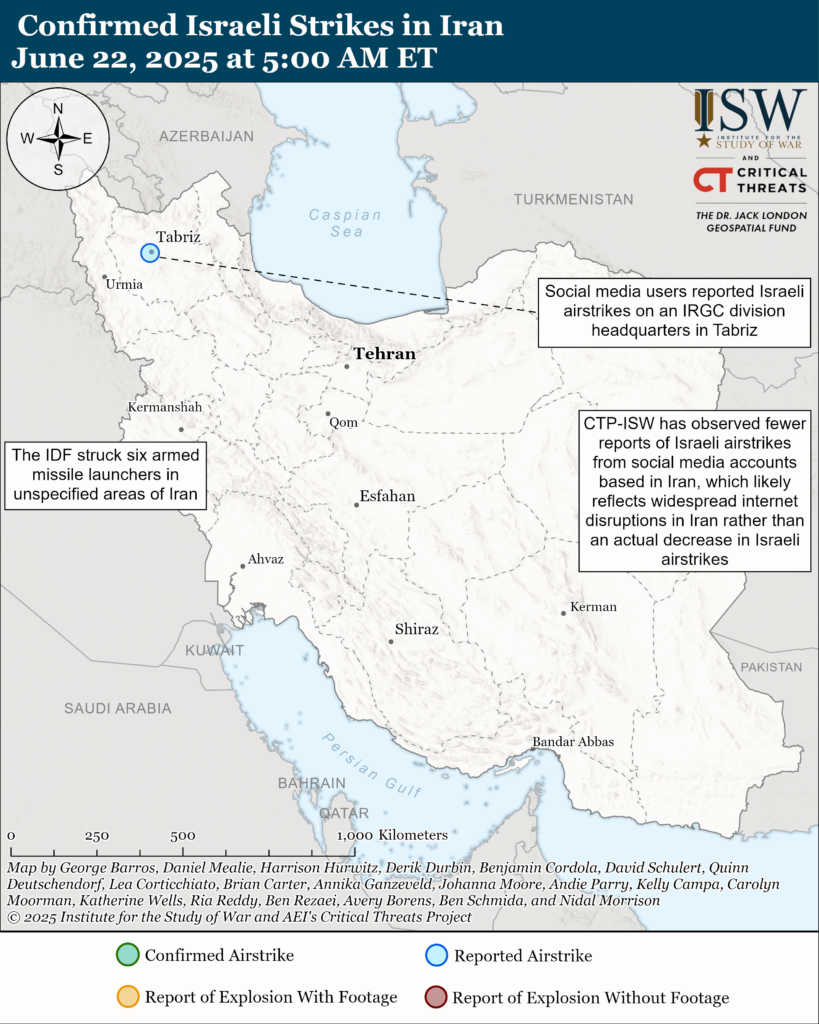
 Eurasia Press & News
Eurasia Press & News
